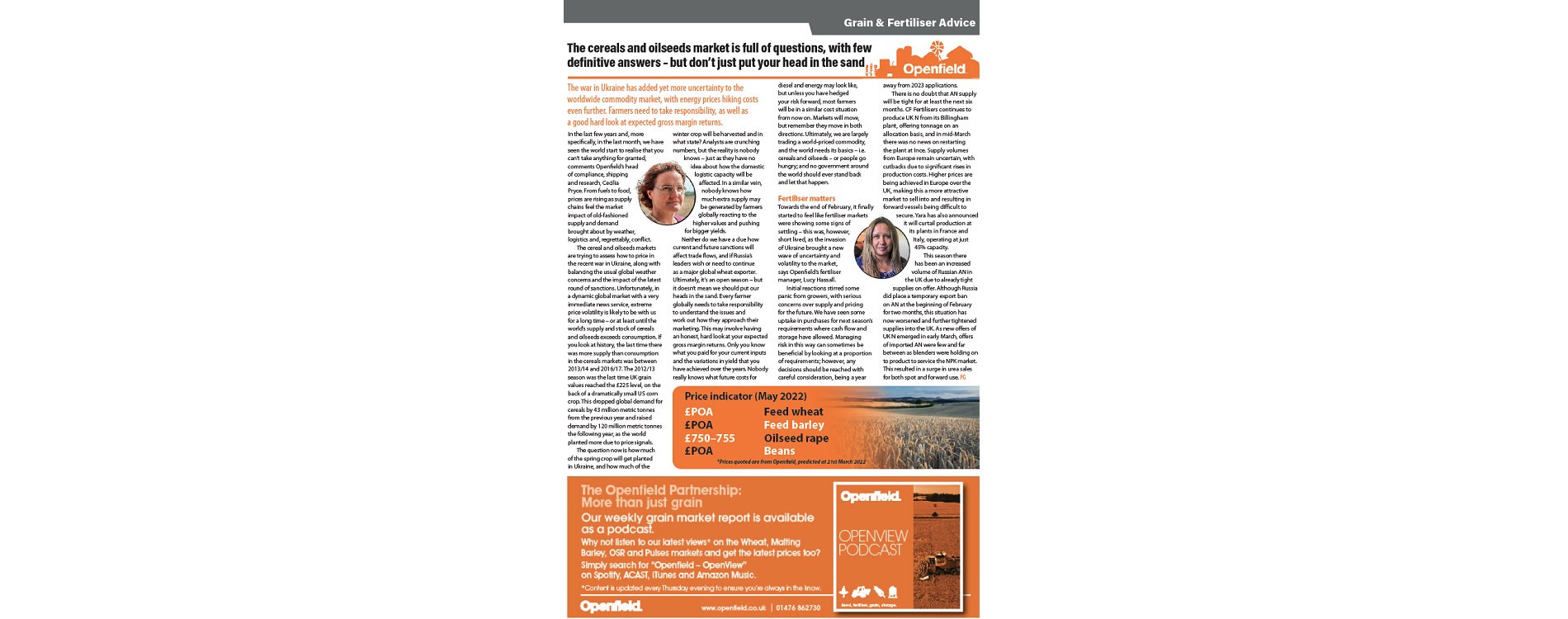The cereals and oilseeds market is full of questions, with few definitive answers – but don’t just put your head in the sand
The war in Ukraine has added yet more uncertainty to the worldwide commodity market, with energy prices hiking costs even further. Farmers need to take responsibility, as well as a good hard look at expected gross margin returns.
In the last few years and, more specifically, in the last month, we have seen the world start to realise that you can’t take anything for granted. From fuels to food, prices are rising as supply chains feel the market impact of old-fashioned supply and demand brought about by weather, logistics and, regrettably, conflict. The cereal and oilseeds markets are trying to assess how to price in the recent war in Ukraine, along with balancing the usual global weather concerns and the impact of the latest round of sanctions. Unfortunately, in a dynamic global market with a very immediate news service, extreme price volatility is likely to be with us for a long time – or at least until the world’s supply and stock of cereals and oilseeds exceeds consumption.
If you look at history, the last time there was more supply than consumption in the cereals markets was between 2013/14 and 2016/17. The 2012/13 season was the last time UK grain values reached the £225 level, on the back of a dramatically small US corn crop. This dropped global demand for cereals by 43 million metric tonnes from the previous year and raised demand by 120 million metric tonnes the following year, as the world planted more due to price signals. The question now is how much of the spring crop will get planted in Ukraine, and how much of the winter crop will be harvested and in what state? Analysts are crunching numbers, but the reality is nobody knows – just as they have no idea about how the domestic logistic capacity will be affected. In a similar vein, nobody knows how much extra supply may be generated by farmers globally reacting to the higher values and pushing for bigger yields. Neither do we have a clue how current and future sanctions will affect trade flows, and if Russia’s leaders wish or need to continue as a major global wheat exporter. Ultimately, it’s an open season – but it doesn’t mean we should put our heads in the sand.
Every farmer globally needs to take responsibility to understand the issues and work out how they approach their marketing. This may involve having an honest, hard look at your expected gross margin returns. Only you know what you paid for your current inputs and the variations in yield that you have achieved over the years. Nobody really knows what future costs for diesel and energy may look like, but unless you have hedged your risk forward, most farmers will be in a similar cost situation from now on. Markets will move, but remember they move in both directions. Ultimately, we are largely trading a world-priced commodity, and the world needs its basics – i.e. cereals and oilseeds – or people go hungry; and no government around the world should ever stand back and let that happen.
Fertiliser matters
Towards the end of February, it finally started to feel like fertiliser markets were showing some signs of settling – this was, however, short lived, as the invasion of Ukraine brought a new wave of uncertainty and volatility to the market. Initial reactions stirred some panic from growers, with serious concerns over supply and pricing for the future. We have seen some uptake in purchases for next season’s requirements where cash flow and storage have allowed. Managing risk in this way can sometimes be beneficial by looking at a proportion of requirements; however, any decisions should be reached with careful consideration, being a year away from 2023 applications. There is no doubt that AN supply will be tight for at least the next six months. CF Fertilisers continues to produce UK N from its Billingham plant, offering tonnage on an allocation basis, and in mid-March there was no news on restarting the plant at Ince.
Supply volumes from Europe remain uncertain, with cutbacks due to significant rises in production costs. Higher prices are being achieved in Europe over the UK, making this a more attractive market to sell into and resulting in forward vessels being difficult to secure. Yara has also announced it will curtail production at its plants in France and Italy, operating at just 45% capacity. This season there has been an increased volume of Russian AN in the UK due to already tight supplies on offer. Although Russia did place a temporary export ban on AN at the beginning of February for two months, this situation has now worsened and further tightened supplies into the UK. As new offers of UK N emerged in early March, offers of imported AN were few and far between as blenders were holding on to product to service the NPK market. This resulted in a surge in urea sales for both spot and forward use.




